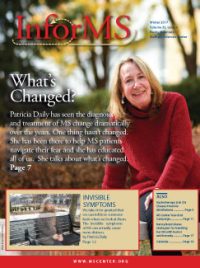
The care and treatment of MS has changed a lot over the years, and the Rocky Mountain MS Center has changed with it. Thirty years ago there were no drugs that targeted MS. There were no sophisticated MRIs. And there was a lot less information. The only constant in MS over the past three decades is that if you receive an MS diagnosis, you are scared.
When Patricia Daily started at the MS Center nearly 30 years ago, treatment focused on managing symptoms. She was there to help her clients navigate their fears. Today she is still educating patients and assuaging their concerns. Daily is a licensed clinical social worker who’s spent most of her career working with our MS community through counseling, conducting MS 101 classes, and community education. She has also been the primary author of InforMS since 2007. While her passion and mission to help MS patients and their families has never changed, her message has evolved over time—now there are more tools available that allow patients to control their MS instead of allowing MS to control them.
Daily’s positive impact on people living with MS and their families is immeasurable. Through this publication alone, Daily has written about everything from the ever-changing landscape of research and science, to the emotional impacts of MS, and topics to help people and their families live with the challenges of this disease. After each issue is published, we hear from readers all over the country (and world) who are grateful for Daily’s ability to explain complex issues in a way that makes sense and connects with them deeply. By sharing her knowledge, perspective and understanding of this complex disease, her articles and community education classes have empowered thousands of people —giving them a better understanding of MS and living with MS.
Daily will be leaving her role at the MS Center at the end of 2017 in an effort to cut back on work and maintain a small private practice. Pete Broderick and Kerri Cechovic sat down with Pat earlier this month to explore her unique perspective and what’s changed in the world of MS over the past 30 years.
InforMS: You started working with the MS Center in 1989, after working in child and family therapy. What was MS care like in those days? How was the MS Center different than it is today?
Pat Daily: In 1989, there were no drugs that targeted MS. Neurologists did not “treat” MS. Mostly patients diagnosed with MS were told there was nothing that could be done, that they should go home and take it easy. However, Jack Burks, the neurologist who founded the RMMSC, believed that we could do a lot more to help patients recover from MS exacerbations and regain function, and he started a comprehensive rehab program. This notion of providing rehabilitation and keeping people with MS active—that was really cutting edge.
When I joined the Center, it had relocated from University Hospital to Swedish Hospital. Swedish was establishing itself as a neurological center of excellence, and they wanted the MS Center there.
The MS Center already had a rehab program but Swedish provided funding to grow those services. We had neurologists, physiatrists (physical medicine and rehab doctors), occupational therapists (OT), physical therapists (PT), a PT and OT gym, speech pathologists who provided cognitive rehab, neuropsychologists who did cognitive testing and research, and a stress management biofeedback therapist. We also had psychotherapists, and that was one of the positions I was hired to fill. And we had a basic science research lab and the tissue bank.
InforMS: How did a visit to the MS Center work at that time?
PD: The MS Center served both inpatients and outpatients. People had a lot more exacerbations 30 years ago. When someone had an exacerbation—maybe once or twice a year— they were usually hospitalized to receive four days of high doses of steroids. And, during this hospital stay, they’d be brought down to the MS Center for three or four hours of different rehab therapies. Our goal was to help them recover the abilities they needed so they could go back home and live independently. The whole point of treating MS was to help people to cope—regain or maintain function, stay active, stay connected, and not get depressed.
I know that the notion that someone could be hospitalized for four days is absolutely bizarre in these managed care times. But that’s actually what would happen. And another thing that would happen is that the entire staff would meet to coordinate patient care. We’d all meet every morning — neurology, rehab, nursing, everybody — and we’d talk about each one of the patients and how they were doing and what they needed. That is another thing that is so different about then and now. Every day I sat in on a cross-disciplinary conversation about what the PT and OT thought, what the neurologist saw and how it all fit together, so that we really developed a comprehensive picture of each patient and what they needed. We all learned from each other. It was a kind of MS immersion program—you learned fast because everyone was speaking the same language and that’s all we did. So I was able to develop a comprehensive picture of what MS was for patients from all these different perspectives. That was such a rare gift.
InforMS: What was different about MS when you started?
PD: Back in the day, people with MS got a lot sicker than they get now. People still get sick, and some still develop a high level of disability, but for many patients it is better now than it was then. Twenty-five years ago, we categorized MS into two forms: relapsing-remitting disease and chronic-progressive disease. The difference between the two was basically that the people who had chronic-progressive were in a wheelchair, and the people who didn’t, weren’t. And we thought the two forms were different. We didn’t yet know that the people who had relapsing remitting disease were still having active MS all the time.
What the MS Center was about in 1990 doesn’t sound very remarkable today. But it was, because 25 years ago, there just wasn’t much of anything for people with MS. There were probably a half-dozen MS Centers around the country at the time, period. Today there are hundreds.
I became an MS “expert” fairly quickly. That’s not because I knew so much. But MS is a rare disease and I did know something and most people didn’t know anything. If you gave two talks and said anything sensible, you were an expert. Now, thousands of care providers and researchers attend the Consortium of MS Centers annual conference every year and thousands more attend the international conferences on MS. So, the landscape of MS expertise has really expanded over the years.
InforMS: When did things begin to move away from the rehabilitation model?
PD: Things began to shift away from rehab when MS specific medications came on the market.
In 1993 the first MS treatment—Betaseron—was released. Initially there was a lottery for people to access the drug, because it was perceived the demand would be so high. The lottery didn’t last very long because patients weren’t as excited about the drug as everyone thought they would be.
The introduction of DMTs was an important breakthrough, though not immediately. We didn’t know how to use interferons when they first came out—for example, to ramp the dose up slowly to prevent side effects. Some patients stopped taking them because of side effects and a lot of people didn’t stay on drug because they didn’t notice any difference in their MS. Although it was said very clearly, “These drugs won’t necessarily keep you from getting worse, and they aren’t going to make you get better. But they might help you get worse slower,” people were still disappointed.
The development of more and more disease modifying therapies, coupled with the changing landscape of health care overall, has certainly shifted the focus of MS care away from the rehabilitation model.
InforMS: How did the MS research landscape change over time?
PD: Pharmaceutical companies have played an important role in MS. The infusion of pharma dollars certainly changed the landscape. Prior to 1993, the MS researcher was a lonely man because it was hard to find money for basic MS research. That changed after the first drugs were introduced. Now a lot of money goes into MS research. And that’s good because it takes boatloads of money to do medical research and that’s hard to come by in academia.
I don’t think our understanding of MS would be where it is today without the pharmaceutical industry. And I don’t think pharma would be where they are today without all the years of painstaking academic research. It’s an iterative process.
InforMS: How did magnetic resonance imaging (MRI) technology change our understanding of MS and how it’s diagnosed and treated?
PD: When I first started it was not uncommon for someone’s diagnostic process to take ten years. The primary tool for diagnosis was a lumbar puncture, and those can give you false- negatives for a long time.
MS was a disease of exacerbations and disability—if you weren’t in the midst of a flare-up, or experiencing a loss in function, it was hard for doctors to pinpoint MS as the cause.
Before a doctor could see MS lesions on an MRI scan, what we now know to be “invisible” symptoms were commonly dismissed as “no problem” or maybe as some unspecified malady. Women were told they were depressed, and men were told they were stressed. It could be very difficult to diagnose MS because people had these weird neurologic symptoms that disappeared by the time they got an appointment with the neurologist, and it could be years before they had another attack.
I started at the MS Center after MRIs were introduced, but they weren’t the MRIs we have now, so it still could still take longer get a diagnosis than it does today. MRI technology is much more sophisticated now and we understand how to use it more effectively. It’s helped advance our understanding of how the disease works and made diagnosing MS easier and faster. Today some people get diagnosed in a day or two.
InforMS: With all these advances, how has the patient experience changed?
PD: Getting diagnosed with MS is like being catapulted into a vast ocean of “unknown.” Dealing with the diagnosis is the process of slowly learning, bit by bit, to make the unknown more known. One thing that’s very different now is the information we can give to patients. It is so much better because we actually understand the disease better. Although there’s still a lot of stuff we can’t tell someone when they are diagnosed—there’s still lots of uncertainty—there is so much more that we can tell them. I think it’s also easier today because we can diagnosis people sooner, so they can resolve at least that piece of the uncertainty sooner. And we have much better treatments, we know how to use them more effectively, and we use them sooner— and all of that helps.
The vast unknown that people can get tossed into is not as vast today as it was when I started. That said, however, a swimming pool of unknown or an ocean full of unknown probably feels about the same if you’re the person being tossed into it. It really doesn’t make that much difference—you still feel in over your head and you’re still floundering. And it still takes time to sort that out.
InforMS: What’s different about the people who are diagnosed today?
PD: We see a broader spectrum of MS patients today. It’s possible that in 1989, we were only looking at a small spectrum of cases, at people with more severe disease. In 1989 you had to have two separate attacks before you could be diagnosed with MS, and those could be separated by years. You had to have a big enough attack that it resulted in symptoms big enough to see, and that also took you in to the doctor. Because there were no treatments for MS, there were people who might have had MS or a possible MS diagnosis and they never followed up on it—there was no reason to follow up because there weren’t any treatments. So, if people could avoid a diagnosis, they did.
The difference today is we don’t have to wait for a second attack before someone can be diagnosed. That’s good because we treat people with minimal symptoms right away, where years ago they’d be sent on their way while their MS silently got worse.
InforMS: Have you seen any changes in broader awareness and perceptions of MS?
PD: I think that perhaps there is more appreciation now for invisible symptoms. People always thought of “Bad MS” as physical impairments. If you were using a cane you were on a slippery slope, and if you were using a walker it was slippery still, and if you were using a wheelchair you had “Bad MS.”
That perception probably still resides in the public mind, but I do think awareness and understanding of invisible symptoms is improving. People with MS will tell you that although not having mobility is a problem, it’s often a problem that you can fix— if you can’t walk, you can roll. If you can’t stay awake though, you’re in trouble. If you can’t see, that’s a problem. And MS can affect people in all of those ways.
InforMS: Given the ever-changing landscape and evolution of our understanding of the disease, what is something fundamental that people treating the disease and living with the disease need to understand?
PD: We are certainly better at diagnosing and treating MS and people don’t develop the same level of disability, but MS is still a very real disease.
People still have it, and they still have to figure out how to live with it. It’s still a nuisance, at best. If everything is going smoothly, then it’s less of a nuisance. When you only have to get an infusion every six months, you don’t have to think about it as much and it’s less intrusive. But it can still rear its ugly head, and when it does, it’s still very scary.
Even if it’s in the background, it’s always there. It doesn’t go away. There’s still this fear. Things can still happen. We know that staying healthy overall can really help, but you never really lose that uncertainty.
For me, an important part of understanding how to counsel people living with MS, has been to recognize that it’s a trauma to be diagnosed with MS. It’s traumatic for people feel that loss of control—to have this thing that can come out of nowhere and takes over.
Learning to deal with that is critical. We can’t make MS go away, but we can help people figure out what they can control, and learn to manage that anxiety more successfully.
InforMS: What’s one thing you’d like people who are newly diagnosed with MS to know?
PD: When people are diagnosed they almost always say, “I’m not going to let MS change my life.” And that almost never works. I think about MS like a jack-in-the-box. You are minding your own business, and all of sudden. MS pops out of the box. And what most people try to do is stuff MS back in the box and sit on the lid, and try to make it go away. But usually, it doesn’t quite fit back in the box. And, it takes a lot of time and energy to sit on the lid. People can spend lots of energy trying not to have MS. That’s what I think about when people say, “It’s not going to change my life.” So, when you’re trying to figure out how to live with MS, maybe try to give it some room, give it some space in your life. Open yourself up to the possibility that life could be different, and not necessarily in a negative way. You can say, “Alright, this stinks and I really don’t like this one bit. Is there anything I can learn from this?”
If you can make a little space for MS, that actually gives you some control.
Several years ago, in an interview about his autobiography, Bruce Springsteen said: “The point I am making in the book is that whoever you are and wherever you’ve been, it never leaves you. I like to think of it like a car. All of your selves are in a car. A new self can get it in, but the old selves can never get out. The point is: Who’s driving?”
I love that image. The MS-you is one, but just one, of the selves in your car. There are lots of other selves as well. Sometimes the MS-you is the one driving. But, over time, your goal is to have the MS-you in the car, but not in the driver’s seat. You can’t throw it out, you can’t lock it in the trunk, but you can find a place for it to sit.






